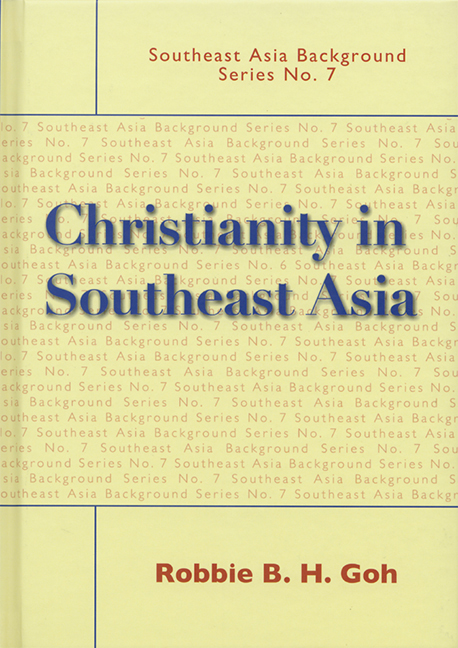Book contents
- Frontmatter
- Contents
- About the Author
- 1 Introduction: Missionary Movements and the Coming of Christianity to Southeast Asia
- 2 The Philippines
- 3 Singapore
- 4 Malaysia
- 5 Indonesia
- 6 Christianity in the Other Countries of Southeast Asia: Brunei, Myanmar, Thailand, Cambodia, Laos and Vietnam
- 7 Christianity in the Other Countries of Southeast Asia: Brunei, Myanmar, Thailand, Cambodia, Laos and Vietnam
- References
3 - Singapore
Published online by Cambridge University Press: 21 October 2015
- Frontmatter
- Contents
- About the Author
- 1 Introduction: Missionary Movements and the Coming of Christianity to Southeast Asia
- 2 The Philippines
- 3 Singapore
- 4 Malaysia
- 5 Indonesia
- 6 Christianity in the Other Countries of Southeast Asia: Brunei, Myanmar, Thailand, Cambodia, Laos and Vietnam
- 7 Christianity in the Other Countries of Southeast Asia: Brunei, Myanmar, Thailand, Cambodia, Laos and Vietnam
- References
Summary
Singapore, although one of the tiniest countries in the world, occupies a significant position in Southeast Asia, not only for its vaunted economic prosperity and governance, but also as one of the strongholds of Christianity in the region. Although the proportion of professed Christians is not very high — 14.6 per cent, according to the 2000 Census of Population — this is high relative to the proportion of Christians in most of the other countries in Southeast Asia. Furthermore, the statistical figure does not really capture the broader influence of Christianity in Singapore — the “social influence” of Christianity mediated through the country's many and well-reputed “mission schools”, the close association of Christianity with middle-class identity (indicated in higher educational levels and correspondingly higher incomes and anglophone competence), and the economic and organizational cachet which is attached to Christian organizations based in Singapore.
Founded in 1819 as a trading base and port for the British East India Company, Singapore was initially administered as one of three “Straits Settlements” (the others being the port of Malacca and the island of Penang, both in peninsular Malaysia), and then as part of Malaya until independence from British rule in 1957. In 1965 Singapore and Malaysia parted ways, in large part due to issues of racial politics (it was perceived, among other things, that Chinese-dominated Singapore would affect Malay political and social control of Malaysia), and the Republic of Singapore came into being. Although the original inhabitants of the island were Malay, the colonial administration's policy of promoting Singapore as a free port and its recruitment of labourers for the rubber and tin industries in Malaya brought in a large number of Tamil and Chinese immigrants, changing the racial and cultural composition of the island significantly.
- Type
- Chapter
- Information
- Christianity in Southeast Asia , pp. 35 - 46Publisher: ISEAS–Yusof Ishak InstitutePrint publication year: 2005



